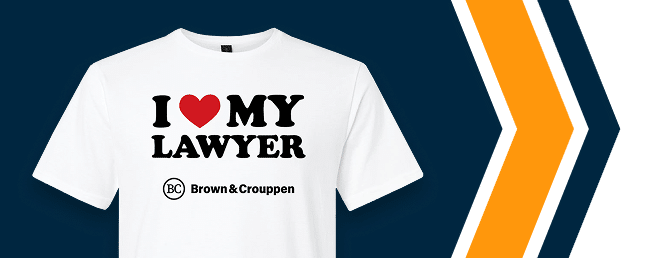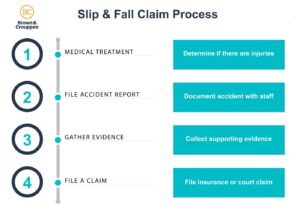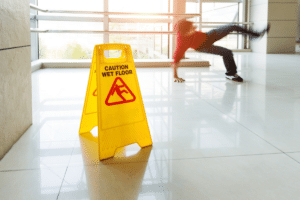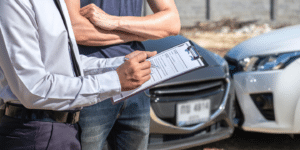- How to Know if You Have A Slip & Fall Claim
- Proving Your Slip and Fall Case
- Notice
- Evidence Needed to Prove Your Slip and Fall Case
- Common Defenses and Challenges in Slip & Fall Cases
- Filing Your Slip and Fall Claim
- Available Damages in Slip & Fall Claims
- Get Help from A Personal Injury Attorney at Brown & Crouppen
How to Know if You Have A Slip & Fall Claim
As simple as it sounds, understanding where and how you fell is the first step to understanding negligence. Determining the exact hazard and the reason for your fall will help determine if a business owner, city manager, landlord, or someone else breached their duty to keep the property reasonably safe.
For example, if a tenant who slipped on icy steps outside her apartment was allowed to proceed with her claim because the landlord had notice of repeated ice buildup in that area but failed to salt or repair drainage issues. This shows that it’s not just the existence of a hazard that matters, but whether the responsible party knew about it and failed to address it. If you can identify that you fell and had also made a complaint about the ice/snow prior, the landlord can be held responsible.
Brown and Crouppen handled a case in 2021 for a tenant whose apartment floor was damaged during maintenance. They left unrepaired for over two years, despite repeated complaints. The tenant eventually fell, aggravating serious back injuries. Brown and Crouppen secured a $637,500 settlement, showing how a landlord’s failure to fix known hazards can create clear liability in slip and fall cases.
Proving Your Slip and Fall Case
The basis of most slip and fall cases is proving two things: first, that the property owner owed you a duty of care to keep the premises reasonably safe; and second, that they knew or should have known about the hazard that caused your injury but failed to fix it or provide a proper warning.
Duty of Care
A duty of care arises from the relationship between the individual who owned or cared for the property and the individual who was injured. Several relationships can stem from a duty.
Those include, but are not limited to:
- A store owner and patron: For example, an employee at a local grocery store notices a spill in the aisle but fails to clean it up or place a warning sign. Thirty minutes later, a customer slips on the spill and is injured.
- Homeowner and guest: For example, a homeowner knows the back porch step is loose, but does not warn a friend who visits. The guest trips on the step and suffers an injury.
- Property owner and children: For example, a property owner builds an inground pool but fails to install a fence, even though neighborhood children often play nearby. A child wanders into the yard and is injured.
- Landlord and tenant: For example, tenants repeatedly complain that the front staircase handrail is broken. The landlord ignores the complaints for weeks, and eventually, a tenant falls and is hurt.
- Restaurant owner and customer: For example, water leaks from a bathroom pipe for days. Despite customer complaints, the problem remains unfixed, and a diner slips on the wet floor.
- City and pedestrian: For example, a pedestrian trips on a cracked sidewalk in a public park. The city had been aware of the damage for months but failed to repair it.
Each of these examples has a duty of care based on their relationship but also comes down to notice.
Notice
The responsible party must have known about the hazard and failed to act reasonably in its remedy. Not every slip and fall creates legal responsibility. Property owners are not automatically liable just because someone gets hurt.
For example, a property owner owes no duty when someone has no invite and no right to be there. A trespasser could be a group of college students sneaking into a construction site at night, and someone gets injured. An example of a lack of notice would be if a shopper drops a bottle of sauce, and within a few minutes, another customer slips on it. These defenses are not foolproof. Whether a property owner had a duty, or “should have known” about a hazard, often comes down to detailed facts, evidence, and how the law applies in your state.
Evidence Needed to Prove Your Slip and Fall Case
Photos & Videos
In slip and fall cases, evidence can disappear quickly. It’s just as important to take photos of the scene of a fall as it is to take photos at the scene of a car crash. If your fall happened at a business or somewhere with surveillance, an attorney can send a preservation letter to the property owner, requiring them to save any surveillance footage of the incident. These images can show the condition of the property at the exact time of your fall.
In 2024, Brown & Crouppen secured a settlement against a grocery store by preserving video footage that showed an employee dropping a clear item, which later caused a customer’s fall. The footage revealed how long the hazard was on the floor, how many customers and employees passed by, and ultimately established fault. Together, video and photos provide some of the strongest proof of negligence, often making the difference between a case that settles quickly and one that’s difficult to prove.
Medical Records
Medical records help connect the accident to your injuries and show the extent of your damages. Without them, it’s nearly impossible to prove how seriously you were hurt. It is important to document everything and to be clear and consistent with your appointment. Every trip to the emergency room, physical therapy, surgery, and more can help create a timeline. Being consistent is so important, as insurance companies often use gaps in treatment to create a false narrative of healing.
Witness Testimony
Having a third-party count of the events is important for independent confirmation of the slip and fall. Anyone can be a witness, but it’s crucial to obtain a detailed account of their recollection as soon as possible, as memories tend to fade quickly. Collecting names and contact information right away is important, as witnesses can be hard to track down later.
Example: A shopper slips on spilled soda in a supermarket aisle. Although the store denied responsibility, a customer’s statement that the spill had been there for at least 20 minutes and that they nearly tripped on it confirms the timing, which is difficult to verify later.
Incident Reports
If your fall happens at a business, chances are an internal incident report was created. These reports, along with other internal documents, can reveal what the staff knew, when they knew it, and what steps they were supposed to take to keep the property safe.
Example: If a customer slipped on a water spill outside a restroom, but the business’s cleaning schedule showed a long gap in inspections, that record could help prove the property failed to take reasonable steps to prevent the accident.
Common Defenses and Challenges in Slip & Fall Cases
Open and Obvious
A common defense that argues that if the hazard is so clear that a reasonable person should have seen and avoided it. A store might argue that a large hole in a parking lot pavement or a fallen item in an aisle was clearly visible, so the customer is at fault for not noticing.
But Missouri courts don’t always let this defense win. In Rider v. Young Men’s Christian Ass’n of Greater Kansas City (2015), a six-year-old boy slipped on a wet cafeteria floor after being directed inside from a snowy playground. The YMCA argued the child should have seen the danger, but the Missouri Court of Appeals disagreed. There was no “plainly visible” hazard, and the court reinstated the full jury award of more than $5.9 million.
Discovery of the Hazard
It can be argued that if the owner/property manager did not know or did not have enough time to discover the hazard, then there was nothing that they could’ve done. However, an attorney can help fight this defense by showing that the hazard existed long enough or that the business should have been doing regular safety checks. Courts look at how long the hazard was there, whether safety policies were followed, and whether the property owner created the risk in the first place.
Illinois courts recognize that a duty can still exist when a risk is reasonably foreseeable, even if the hazard itself was obvious or had been seen before. In Ward v. K Mart Corp. (1990), a customer carrying a large mirror walked out of a Kmart and struck a concrete post by the exit. Kmart argued it had no notice of any hazard because the post was permanent, obvious, and the customer had already seen it on his way in. The Illinois Supreme Court rejected that argument. The court explained that Kmart should have anticipated the risk that customers carrying bulky merchandise might be distracted or unable to see the post. Even an obvious condition can still create liability if it’s foreseeable that people will forget, overlook, or be distracted from it.
Comparative Fault
In both Illinois and Missouri, comparative fault comes into play in slip and fall lawsuits. This means a jury can divide responsibility for the accident between the injured person and the property owner, which directly affects the damages awarded.
- Illinois (Modified Comparative Negligence): A plaintiff may recover damages even if they are partly at fault, but only if they are 50% or less responsible. If they are 51% or more at fault, they recover nothing.
- Missouri (Pure Comparative Fault): A plaintiff may recover damages even if they are more than 50% at fault. However, the total recovery is reduced by their percentage of fault.
For example, an individual is walking through a store while looking at their phone. They slip on a puddle of spilled water and are injured. At trial, the jury found the customer was 20% at fault due to distraction, but the store was still found negligent for not cleaning up the spill.
- If the verdict is $100,000, the plaintiff recovers $80,000 after a 20% reduction.
- In Illinois, if the jury instead found the plaintiff 51% at fault, the plaintiff would recover nothing.
- In Missouri, even if the plaintiff were found 80% at fault, they could still recover 20% of the damages ($20,000).
Filing Your Slip and Fall Claim
A statute of limitations is the period within which you must file a lawsuit. In Missouri, negligence claims, like slip and fall accidents, have a five-year statute of limitations (Mo. Rev. Stat. § 516.120). This means that, from the date of your injury, an individual has five years to seek an attorney and file the claim. In Illinois and Kansas, the statute of limitations is two years from the date of your injury.
Keep in mind, this doesn’t mean you should wait until the last minute. The more proactive you are with this, the better the attorney can investigate, preserve evidence, and safeguard key proof. Many businesses only keep surveillance footage for 30–60 days before it’s recorded over. If someone were to slip and fall in a store, the surveillance footage would be used as key evidence and should be preserved.
Available Damages in Slip & Fall Claims
If you are injured in a slip and fall accident, you may recover both economic damages and non-economic damages. Claims against government entities may have special limits or strict notice requirements, but in most cases, the jury can award full compensation. The final verdict will then be adjusted if the jury finds any comparative fault on the part of the injured person.
Economic Damages
- All medical bills
- Future medical expenses for ongoing treatment
- Lost wages
- Loss of future earning capacity, if you’re unable to return to your job
Non-Economic Damages
- Pain and suffering from the injury and recovery
- Emotional distress, anxiety, and depression caused by the accident
- Loss of normal life and the ability to engage in your typical hobbies and activities
In February 2024, the trial attorneys at Brown & Crouppen achieved a $2 million federal jury verdict in a Missouri slip and fall case involving a snow-covered parking lot. The client required three major ankle surgeries after the fall. The verdict reflected not just the client’s medical bills for surgeries and various doctors’ appointments, but also her pain, suffering, and the long-term impact of her injuries.
Get Help from A Personal Injury Attorney at Brown & Crouppen
When dealing with a slip and fall accident claim, it is crucial to consult with an experienced attorney who can guide and advise you through the claim. Early legal intervention can help protect your rights and improve your chances of compensation. The choice of a lawyer is an important one and should not be made without careful consideration.
Our legal team is here to help you learn more about your legal options and evaluate the strength of your Slip & Fall claim. We care about our community and have dedicated our practice to helping injury victims recover justice, accountability, and compensation.
Get started today with your free case evaluation by visiting Brown & Crouppen online or by calling us at 800-536-4357. Our St. Louis and Kansas City slip and fall lawyers have helped clients recover over $1 billion in settlements and verdicts. And remember, there are no upfront costs or legal fees – we only get paid if you win.










